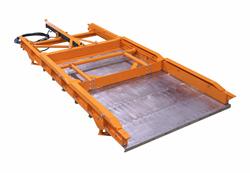Scavenger Conveyor controls fugitive material in tough conditions

Description
A patented scavenger conveyor system, designed to minimize problems with fugitive material in tough applications like underground mines and low-overhead transfers, has been introduced by Martin Engineering. The new MARTIN® Carryback Capture System transfers belt cleaning residue back into the material stream, avoiding cleanup labor, injury potential, and dust hazards associated with buildup. The rugged construction of the scavenger conveyor system delivers excellent durability and longevity under harsh conditions, helping coal handlers and ore miners reduce safety hazards while preventing material accumulation that can impede conveyor components and increase system downtime.
The MARTIN® Carryback Capture System’s modular design was developed amidst a growing demand for tertiary cleaning systems and a trend driven in part by environmental, regulatory, and safety pressures to improve coal conveying and reduce dust emissions—as seen in OSHA’s Combustible Dust National Emphasis Program.
“Scavengers collect carryback removed from a conveyor belt by a cleaning system installed off the head pulley, and return that material to the main cargo stream in the head chute,” explained Martin Engineering’s R. Todd Swinderman.
“By preventing fugitive material from encapsulating belt cleaners and other components, an effective scavenger conveyor helps improve conveying efficiency and reduce the exposure of maintenance personnel to potential hazards when working around moving equipment. In coal operations, it also helps minimize explosion risk,” he added.
Commonly found in underground mines, scavenger conveyors are typically installed in applications where the main conveyor belt is nearly horizontal, so recovered material will not flow due to gravity and must be moved by mechanical means. The Carryback Capture System from Martin Engineering stands just 13 inches (330 mm) high, allowing it to fit into tight spaces under conveyors or in low overhead conditions.
The MARTIN® Scavenger Conveyor uses an electrically-driven hydraulic cylinder to push a steel cleaning blade—or in a longer scavenger, a series of blades—across the system’s collecting pan, sliding the “slop and fines” in the trough toward the conveyor discharge. On the return stroke, the plows ride up onto tracks to be pulled back to the starting position, without dragging material in the wrong direction. The cleaning cycle of each unit automatically adjusts to match the belt speed of the main conveyor.
The Carryback Capture System is manufactured in modular, four-foot (1.2 m) sections, so it can be constructed in lengths from 8 to 24 feet (2.4 to 7.3 m). Units are available to match belts from 36 to 72 inches (900 to 1800 mm) wide.
The MARTIN® Carryback Capture System’s modular design was developed amidst a growing demand for tertiary cleaning systems and a trend driven in part by environmental, regulatory, and safety pressures to improve coal conveying and reduce dust emissions—as seen in OSHA’s Combustible Dust National Emphasis Program.
“Scavengers collect carryback removed from a conveyor belt by a cleaning system installed off the head pulley, and return that material to the main cargo stream in the head chute,” explained Martin Engineering’s R. Todd Swinderman.
“By preventing fugitive material from encapsulating belt cleaners and other components, an effective scavenger conveyor helps improve conveying efficiency and reduce the exposure of maintenance personnel to potential hazards when working around moving equipment. In coal operations, it also helps minimize explosion risk,” he added.
Commonly found in underground mines, scavenger conveyors are typically installed in applications where the main conveyor belt is nearly horizontal, so recovered material will not flow due to gravity and must be moved by mechanical means. The Carryback Capture System from Martin Engineering stands just 13 inches (330 mm) high, allowing it to fit into tight spaces under conveyors or in low overhead conditions.
The MARTIN® Scavenger Conveyor uses an electrically-driven hydraulic cylinder to push a steel cleaning blade—or in a longer scavenger, a series of blades—across the system’s collecting pan, sliding the “slop and fines” in the trough toward the conveyor discharge. On the return stroke, the plows ride up onto tracks to be pulled back to the starting position, without dragging material in the wrong direction. The cleaning cycle of each unit automatically adjusts to match the belt speed of the main conveyor.
The Carryback Capture System is manufactured in modular, four-foot (1.2 m) sections, so it can be constructed in lengths from 8 to 24 feet (2.4 to 7.3 m). Units are available to match belts from 36 to 72 inches (900 to 1800 mm) wide.
